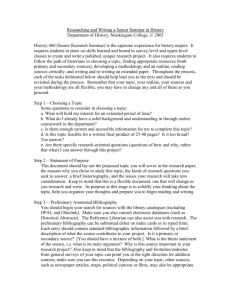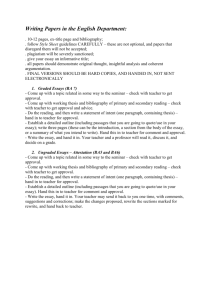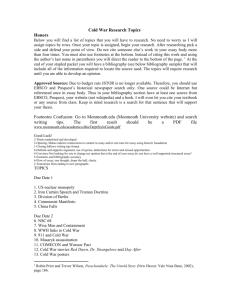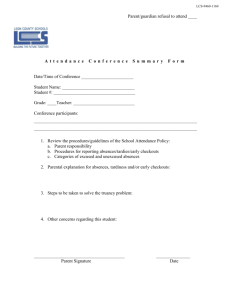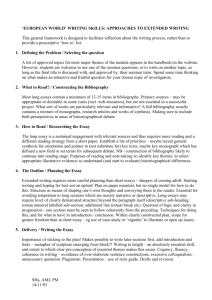nt370-james-t.spilman-d. - Generation Bible College
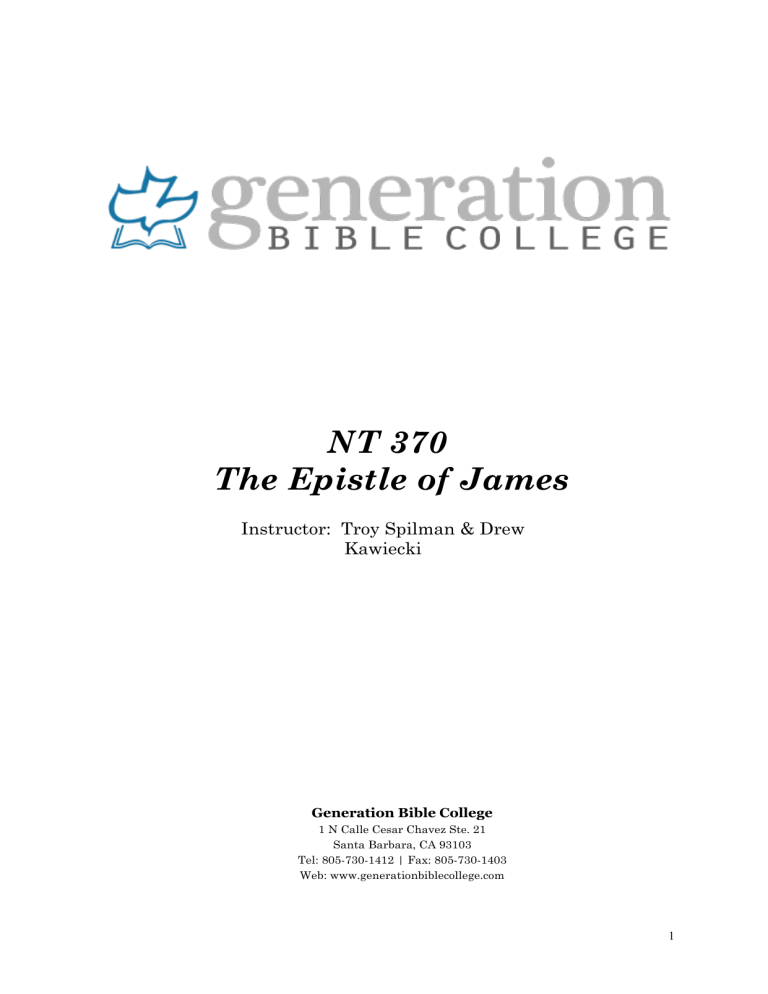
NT 370
The Epistle of James
Instructor: Troy Spilman & Drew
Kawiecki
Generation Bible College
1 N Calle Cesar Chavez Ste. 21
Santa Barbara, CA 93103
Tel: 805-730-1412 | Fax: 805-730-1403
Generation Bible College
1
Generation Bible College
NT370 James Syllabus
Fall 2012
Instructor
Troy Spilman & Drew Kawiecki
Course Title
NT370- The Epistle of James
Time and Location
Wednesday @ 13:00 (1:00 p.m.) at CC Santa Barbara
Course Credit : 2 Credits
Required Text
NKJ Bible
Be Mature , Warren Wiersbe
Course Description
NT370 is an expositional examination and evaluation of the general epistle of James.
This book will be considered in its historical context, and how it relates to the individual believer, the Church as a whole, and the world today. The various themes and doctrines that this book presents will be treated as it appears in its inspired order.
Course Goal
The goal of NT370 is to grow deeper and stronger in our walk with our Lord Jesus Christ.
The goal of this course has a two-fold objective:
1. Firstly to gain an understanding of the epistle of James in its historical context, namely the messages to its immediate audiences.
2. Secondly to see how these messages can be spoken and applied to the individual believer, the
Church as a whole, and the world today.
May it be noted that the purpose of the two objectives stated above, as well as the treatment of the various themes and doctrines in the epistle of James serve the purpose of achieving the desired goal, a closer, more obedient walk with our Lord Jesus to whom be all glory.
Course Requirements
There are four requirements:
1.
Three short essays consisting of 1-2 pages will be assigned. This will constitute 20% of your final grade .
2.
The Midterm exam (Oct.17) will consist of questions regarding the material covered up to that point. This exam will be worth 25% of your final grade.
3.
Submit a 3-4 page (double spaced) research paper on a subject that will be determined at a later date. The research paper will be worth 30% of your final grade.
4.
The Final Exam (Dec.12) will cover material since the mid-term exam. The final will be worth 25% of your final grade.
2
Tuesday:
Course Schedule
1.
September 5
2.
September 12
3.
September 19
4.
September 26: First Paper Due
5.
October 3
6.
October 10: Second Paper Due
7.
October 17: Mid-term Exam
8.
9.
October 24
October 31
10.
November 7: Third Paper Due
11.
November 14
12.
November 21
13.
November 28
14. December 5: Final Paper Due
15. December 12: Final Exam
Class Topic:
Intro & Overview (TS)
James 1:1-11 (DK)
James 1:12-27 (TS)
James 2:1-13 (DK)
James 2:14-26 (DK)
James 3:1-12 (TS)
James 3:13-18 (DK)
Speakers Week
James 4:1-12 (TS)
James 4:13-17 (DK)
James 5:1-6 (Guest Teacher)
Thanksgiving Break
James 5:7-12 (TS)
James 5:13-20 (DK)
Summary, Analysis of major theme (TS)
Attendance & Grading Policy
GBC requires 100 percent attendance for all classes taken by students.
All absences will be handled by the Registrar’s Office and
NOT the teacher. Whenever an absence occurs (for whatever reason) the student must make up the class. For all absences, students need to fill out the absence authorization form available in the Front Office. This form completed, along with the one-page summary, is to be turned in to the absence authorization box in the Front Office. In addition, any homework that was due the day of absence should be included as well. This must be completed and submitted within two weeks of the absence.
Short Essay Assignment
A substantial portion of the students’ grade depends on their performance on the Short Essay questions. Below are questions from the Book of James. To receive full credit for the Short Essay portion of their grade, the student must select and answer each of the topics below. On a following page is a sample answer from a previous class. The sample answer is intended to give the student and idea of the length, form, and completeness of a successful answer to a Short Essay question.
First Paper: Due 9/26
A. In James 1:1, the author refers to his original audience as “the twelve tribes which are scattered abroad.” Specifically, whom did James refer to with this phrase? Why did he refer to his audience this way?
B. James 1:12-15 is one of the most developed statements regarding the phenomenon of temptation in the New Testament. List and explain four other New Testament passages relevant to the phenomenon of temptation.
Second Paper: Due 10/10
A. James 2:1-7 exhorts Christians to a hold certain attitude towards rich and poor. Describe (in your own words) the thinking of James in this section, and list and explain two additional Old Testament
3
passages regarding rich and poor, and two additional New Testament passages regarding rich and poor.
B. James 2:14-19 discusses the dynamic of faith and works in the Christian life. Passages such as these have sometimes been used to say that James contradicts other passages in the New Testament, and especially passages by the Apostle Paul that insist that salvation is a matter of faith and not works.
List and explain two passages from the writings of the Apostle Paul that some might believe contradict this passage from James, and two passages from the writings of the Apostle Paul that are in clear agreement with this passage from James. Additionally, answer this question: Do you believe that
James contradicts Paul?
Third Paper: Due 11/7
A. James 3:1-6 speaks of the power of the tongue to either benefit or harm others. List and explain five passages from the Book of Proverbs that are consistent with this theme.
B. In James 3:17, the author describes the nature of heavenly wisdom. List the terms James used to describe this wisdom, and explain the meaning of each term individually.
C. James 4:6 quotes Proverbs 3:34 (also quoted in 1 Peter 5:5) regarding the connection between pride, humility, and grace. Why does God give grace to the humble? Why does pride make God resist someone?
Final Paper: Due 12/5
A. James 4:17 is a plain and challenging statement regarding Christian ethics. State the principle of this verse in your own words, and describe three real-life situations where the principle might apply.
B. James 5:14-15 describes the practice of anointing one with oil and prayer for the healing of the sick. Explain this passage in your own words; explain if this should or should not be practiced in the church today; and if you believe it should be practiced in the church today, describe how you believe this should be practiced.
C. Write an essay describing what ideas and themes throughout the Book of James that have been the most interesting and personally meaningful to you.
All Absences will incur a penalty.
1. If the class is made-up by MP3 available in the library, the absence penalty is a oneincrement grade deduction. (i.e. A to A-, A- to B+, etc.)
2. If the class is not made up, the penalty is a two-increment deduction. (i.e. A to B+, B to C+, etc.)
In the event of excessive absences due to illness and/or family emergencies, the student may need to withdraw from school and return the following semester when his or her health improves.
Tardies
For every two tardies there will be a one-increment grade deduction.
4
Grading
This course is graded on a letter grade basis, with the Instructor responsible for assigning a grade. The grade will be based on the four assignments: Textbook reading summaries, Mid-
Term Exam, Research paper, and the Final Exam. Out of 100 possible points, the final grade will be based on the number of accumulated points. The following grading scale will be used:
A 95-100
A- 90-94
B+ 87-89
B 83-86
C+ 77-79
C 73-76
C- 70-72
D+ 67-69
D 63-66
D- 60-62
F 59 and below
Absences & Tardies
Absences and tardies affect the final letter grade. For example, if you receive an A in the assignments an absence will bring your final grade down to an A-.
5
Writing a Term Paper
What is included in a Term Paper?
A term paper is a chance for you to prove that have obtained a good grasp on the course and its subject. You must demonstrate that you can academically research a topic, glean specific information on it, and present the materials in an organized format.
The information should be researched and gathered from several sources (i.e. books, journals, tapes, the internet, magazine articles, or lectures). It is important to keep a careful record of where you found your work and include this information in the footnotes, as well as the bibliography (located at the end of your paper).
Also included in the term paper, must be personal application on how the subject(s) have personally changed your life. This is a very important part of your paper and gives you a chance to share from your heart, what the Lord has done through the course.
Writing your Paper
Read over the guidelines given on your syllabus and be sure they are fully understood. A good paper is always, at least in part, a result of closely followed instructions. Should you have any questions on these guidelines, please call Troy Spilman (805-729-3215) or Drew
Kawiecki (805-729-0921).
Grammar and Style Tips
Pay attention to grammar and spelling. They make your paper readable and help give your ideas credibility. Encourage readability and continued interest by using words with which you are familiar and comfortable.
Proofread your paper several times and have others proofread it as well. Ideally, get someone who knows you well and you know will give you an honest opinion, to read your paper. If they can understand it, then your writing style is probably clear. If not, rework your ideas.
Font
The paper should be written in either Times New Roman or Century Schoolbook font in 12point type. If these fonts are unavailable, choose a well known and easy to read font style that does not distract the reader from the content of your paper. Footnotes and endnotes should be typed in the same font as your text in 10-point type.
Title Page
A Title Page should include all of the following beginning at the top of your page and being evenly distributed throughout the page: School Name, Title of Paper, Course and Course
Number, Name of Instructor, Your Name, and Date. It is to be on a separate sheet of paper, appearing at the top of your Term Paper.
Introduction
Your introduction should include an opening statement that tells the reader what your paper is about. Open with a strong topic sentence that will grab your reader’s attention. Next, give a brief overview of what your reader can expect to read in the paragraphs that follow. If you set out to prove a point, make a strong case for it, and stick to that premise all the way through your paper.
6
Body
Paragraphs should be five to seven sentences. Begin each paragraph with a topic sentence.
Use explanations, illustrations, and details to help the reader gain an understanding of the topic of your paragraph. Also, be sure to use clear and helpful transitional sentences to connect ideas from one paragraph to the next.
As you write your paper, stick to your main topic and be careful not to get sidetracked with non-related issues. Consider making an outline of your theme and key points before you begin writing. This will help you stay on track as you write. Pronouns such as I, me, we, us, my, our , should be avoided in academic writing and reserved for a devotional paper.
Substitute third person phrases to refer to yourself such as “the writer”, “the author”, “this paper”, “this study”, “this research”, if needed.
Personal Application
When writing personal application, it is important to remember to use the pronouns I and me .
If the pronouns we, us, or you are used, it will not be counted as personal application. All we are looking for in this section is for you to share your heart on what the Lord has shown you through the subject(s). Again, we are not looking for what the Lord could be showing us in this course, but what He is showing you personally . Personal application should not occupy the majority of your paper; one page is sufficient (the last page).
Bibliography
A bibliography is a complete list of all reference sources consulted and used in the preparation of the term paper. A bibliography goes on a separate sheet of paper and should be the last page of your completed paper.
Each bibliography entry should give the following information: name(s) of author(s), full title of the source, city of publication (specify state of publication when necessary), publisher, and date of publication. The bibliography is single-spaced for each entry and double-spaced between entries. The first line occurs at the left margin, and additional lines are indented five spaces. For correct format and style for a bibliography entry, see the examples below:
Single Volume Book – One Author
Smith, Chuck. Why Grace Changes Everything . Eugene, Oregon: Harvest House
Publishers, 1994.
Special Forms – Lectures
Hoekstra, Bob. “The Surpassing Value of Knowing Christ.” Sunday Chapel lecture.
Calvary Chapel Bible College. February 6, 2000. Murrieta, California.
Please Note: All well-known resources (i.e. dictionaries, encyclopedias, Bibles) need not be referenced in your bibliography. Simply enter them as footnotes within your paper. See footnote examples below:
A Scripture Reference:
1 1 Cor. 13:1-13 KJV.
An Encyclopedia Reference
2 “Depression of the 1930’s” in New Grolier’s Encyclopedia , 1993 ed. [CD-ROM]
(Danbury, Conn.: Grolier Electronic Publishers, 1993).
1
7
Footnotes / Endnotes
All sources used in your term paper must be referenced in either footnotes or endnotes.
Above are examples of how these should be formatted. Whenever using outside resources, they should always be referenced somewhere in your paper, and be made distinguishable from the rest of the contents of the paper. Footnotes and endnotes should be typed in 10 point type with the following information:
1 Henry C. Thiessen, Lectures in Systematic Theology (Grand Rapids: Eerdmans Publishing,
1979), 25.
For further information about writing a research paper and detailed examples of footnote or bibliography entries, please refer to Chapman, James A. Handbook of Grammar &
Composition , 3 rd
edition, published by Pensacola Christian College (1996).
2
8

